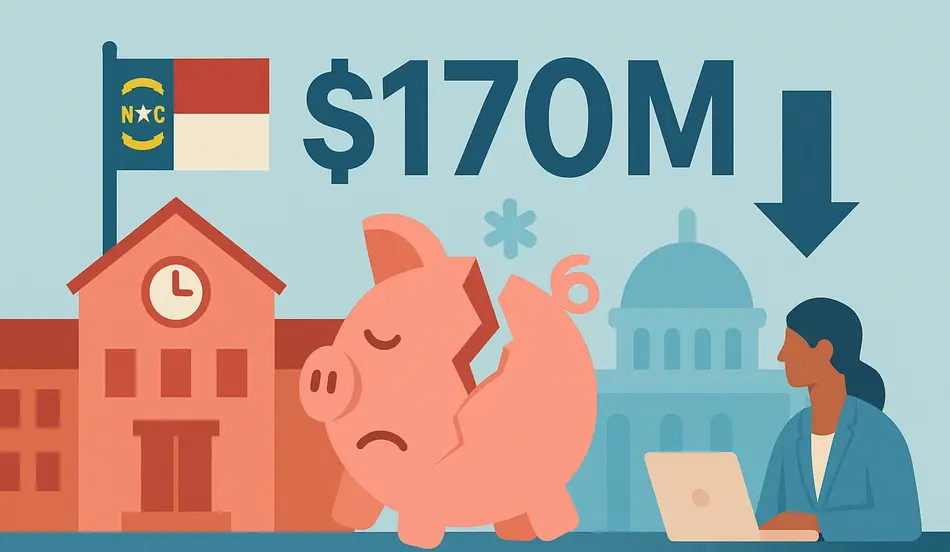North Carolina is facing an unprecedented education funding crisis as federal authorities abruptly froze approximately $170 million in critical education funds. This shocking development threatens to devastate school districts across the state, particularly in rural communities still recovering from natural disasters. With potential layoffs of 1,000 educators looming and vital programs for 10,000 at-risk youth in jeopardy, state officials are racing against time to prevent catastrophic consequences for 1.5 million students returning to school within weeks.
The Sudden Education Funding Crisis Explained
The education funding crisis in North Carolina erupted without warning when state officials received a brief three-sentence email the night before the freeze took effect. According to Attorney General Jeff Jackson, the Department of Education provided virtually no details about the freeze and has since refused to answer questions from state officials desperately seeking clarity.
“We had no notice. It wasn’t even the day before. It was the night before,” explained Jackson. “We got a three-sentence email along with the rest of the country that included basically no detail and said these funds would now be frozen until further notice.”
Financial Impact on North Carolina Schools
The scope of this education funding crisis is staggering:
- Approximately $170 million in federal education funding frozen
- Potential layoffs of roughly 1,000 educators statewide
- Affects preparation for 1.5 million students returning to school
- Disproportionate impact on rural counties still recovering from Hurricane Helen
- An estimated $18 million cut to hurricane-affected school districts alone
This abrupt funding freeze represents one of the most significant financial challenges facing American public education in recent years, comparable to budget crises seen during economic downturns.
Critical Programs at Risk
The education funding crisis threatens numerous essential programs that serve vulnerable student populations across North Carolina:
- Afterschool programs serving over 10,000 at-risk youth
- STEM education initiatives critical for future workforce development
- Mental health services and suicide prevention programs
- Adult literacy classes serving communities with educational gaps
- Special education support services
- Professional development for teachers
- Technology infrastructure maintenance and upgrades
These programs represent vital support systems for students who often have limited resources at home, potentially widening achievement gaps that already plague American education.
Rural Communities Bear the Brunt of the Education Funding Crisis
While the education funding crisis affects the entire state, rural communities face particularly severe consequences. Attorney General Jackson identified Ashe, Polk, and Graham counties as the most heavily impacted, with cuts potentially reaching $300-$400 per student.
Disproportionate Impact on Rural Schools
Rural school districts face unique challenges during this education funding crisis:
- Limited local tax base to compensate for lost federal funds
- Greater reliance on federal funding for basic educational services
- Higher transportation costs per student due to geographic dispersion
- Difficulty attracting and retaining qualified educators even before the crisis
- Many still recovering from Hurricane Helen’s devastating impact
- Limited access to alternative educational resources in the community
“The most heavily impacted counties in our state are going to be our rural counties,” Jackson emphasized. “Those are very rural counties where we estimate that the cut per student will be $300 to $400. That is a huge chunk.”
Hurricane Recovery Complications
The education funding crisis comes at a particularly difficult time for communities still rebuilding after Hurricane Helen:
- Approximately $18 million in cuts targeting hurricane-affected counties
- Infrastructure repairs already straining local budgets
- Displaced families still working to establish stability
- Emotional and psychological impacts on students requiring additional support
- Community resources already stretched thin by recovery efforts
This double burden of natural disaster recovery and education funding cuts creates a perfect storm for educational disruption in these vulnerable communities.
Exacerbating the Teacher Shortage Crisis
North Carolina already struggles with what Attorney General Jackson described as a “famous teacher shortage.” The education funding crisis threatens to worsen this situation dramatically, potentially triggering a cascade of negative consequences throughout the education system.
Current Teacher Shortage Conditions
The pre-existing teacher shortage in North Carolina includes:
- Unfilled positions in critical subject areas like math, science, and special education
- Reliance on long-term substitutes without specialized training
- Larger class sizes reducing individualized attention
- Teacher burnout from covering additional duties
- Competitive disadvantage compared to neighboring states’ compensation packages
- Declining enrollment in teacher preparation programs
“North Carolina has a famous teacher shortage at this point,” Jackson noted. “It’s something that some folks in the general assembly have been trying to remedy, and I give them credit for that. This would be a shock to the system in what is already an extremely fragile condition.”
Emergency Hiring and Firing Decisions
The timing of this education funding crisis forces districts to make immediate personnel decisions:
- Potential non-renewal of contracts for approximately 1,000 educators
- Hiring freezes for critical positions
- Uncertainty for teachers considering job offers
- Redistribution of responsibilities among remaining staff
- Potential consolidation of classes and programs
- Administrative resources diverted to crisis management rather than educational improvement
🎓 Explore Education Jobs with Confidence
Looking for education jobs during this uncertain time? WhatJobs helps you discover career opportunities that match your skills, qualifications, and goals—from teaching and administration to counseling and support roles.
Whether you’re an experienced educator or just starting out, find your next role in a school, college, or training center that values what you bring to the classroom.
Browse Education Jobs →Limited State Options in the Education Funding Crisis
When asked about state-level solutions to the education funding crisis, Attorney General Jackson painted a bleak picture of North Carolina’s fiscal situation.
Emergency Fiscal Conditions
North Carolina faces significant constraints in addressing the education funding crisis:
- State operating in “emergency fiscal situation” according to Jackson
- Limited reserves available for education funding gaps
- Competing priorities for available emergency funds
- Constitutional requirements for balanced budget limiting flexibility
- Potential need for special legislative session to address funding
- Tax revenue projections insufficient to cover the shortfall
“We are operating in an emergency fiscal situation right now in North Carolina,” Jackson explained. “Our state superintendent, Mo Green, believes there is a couple of months of stop-gap funding that we may have access to, but a lot of these counties and school districts have to assume that they are not going to have money beyond that point.”
Forced Decision-Making Under Uncertainty
The education funding crisis forces districts to make difficult choices with incomplete information:
- Districts making hiring/firing decisions based on worst-case scenarios
- Program cuts being planned without clear guidance on funding restoration timeline
- Budget reallocation discussions occurring mid-fiscal year
- Contractual obligations complicating rapid adjustments
- Community stakeholders demanding answers officials don’t have
- Long-term planning paralyzed by short-term uncertainty
This uncertainty compounds the direct financial impact, creating additional administrative burdens and diverting focus from educational improvement to crisis management.
Legal Challenge to the Education Funding Crisis
Facing limited options at the state level, North Carolina has joined 24 other states in filing a lawsuit challenging the federal government’s authority to freeze these education funds.
Multi-State Legal Response
The coordinated legal challenge includes:
- 25 state attorneys general joining forces
- Request for preliminary injunction as emergency measure
- Constitutional arguments against federal authority to withhold allocated funds
- Procedural challenges to the lack of notice and comment period
- Documentation of harm to educational systems across multiple states
- Precedent-setting implications for federal-state education funding relationships
“The main request in the lawsuit right now is a preliminary injunction,” Jackson explained. “We’re asking the court to treat this as an emergency and say that while we resolve this litigation, which could take many months or longer, we want them to lift the freeze on funding right now.”
Race Against Time
The legal challenge faces a tight timeline:
- Only weeks remaining before the new school year begins
- Court proceedings typically move slower than educational hiring cycles
- Potential for irreparable harm if injunction not granted quickly
- Evidence gathering ongoing to demonstrate immediate impact
- Uncertainty about judicial receptiveness to emergency arguments
- Parallel diplomatic efforts to resolve the situation outside court
“Time is of the essence,” Jackson emphasized. “We have a few weeks really to avoid the worst consequences of this.”
Long-Term Implications of the Education Funding Crisis
Beyond the immediate emergency, this education funding crisis raises fundamental questions about educational funding stability and federal-state relationships in educational governance.
Systemic Vulnerabilities Exposed
The crisis highlights several systemic issues:
- Overdependence of critical programs on potentially unstable federal funding
- Lack of transparent communication channels between federal and state education authorities
- Insufficient emergency reserves for educational continuity during funding disruptions
- Vulnerability of rural and economically disadvantaged districts to funding fluctuations
- Need for more flexible state funding mechanisms to address federal shortfalls
- Potential chilling effect on innovative programs dependent on federal support
Potential Reform Discussions
The education funding crisis may catalyze broader conversations about:
- Creating more stable, multi-year funding commitments for critical educational programs
- Developing transparent protocols for any necessary funding adjustments
- Establishing emergency funds specifically for educational continuity
- Reexamining the balance of federal, state, and local education funding responsibilities
- Improving coordination between different levels of educational governance
- Protecting vulnerable student populations from funding disruptions
These discussions could ultimately lead to more resilient educational funding systems, though immediate crisis management remains the priority.
📘 Hiring? Find Qualified Education Professionals
Looking to hire qualified educators during this challenging time? WhatJobs makes it easy to reach top talent in education, from experienced teachers to school administrators and support staff.
Post your job listings for free and connect with motivated candidates across North Carolina and beyond who are ready to make a difference in your classrooms and campuses.
Post Education Jobs for Free →FAQ About the Education Funding Crisis
Q: What caused the education funding crisis in North Carolina?
A: The education funding crisis in North Carolina was triggered by an abrupt federal freeze of approximately $170 million in education funds. State officials received only a three-sentence email the night before the freeze took effect, with no detailed explanation provided by the Department of Education.
Q: How many educators could lose their jobs due to this education funding crisis?
A: According to North Carolina Attorney General Jeff Jackson, the education funding crisis could result in approximately 1,000 educators losing their jobs across the state, with rural districts likely to be hit hardest.
Q: Which counties in North Carolina are most affected by the education funding crisis?
A: The education funding crisis disproportionately impacts rural counties in North Carolina. Attorney General Jackson specifically identified Ashe, Polk, and Graham counties as facing the most severe cuts, potentially reaching $300-$400 per student.
Q: What is being done to resolve the education funding crisis?
A: North Carolina has joined 24 other states in filing a lawsuit seeking a preliminary injunction to lift the funding freeze while the larger legal questions are resolved. State Superintendent Mo Green is also exploring potential stop-gap funding that might cover a couple of months of expenses while a more permanent solution is sought.
Q: How does this education funding crisis affect programs for at-risk youth?
A: The education funding crisis threatens afterschool programs serving over 10,000 at-risk youth in North Carolina, along with STEM education initiatives, mental health services, suicide prevention programs, and adult literacy classes that provide essential support to vulnerable populations.
Q: When might the education funding crisis be resolved?
A: The timeline for resolving the education funding crisis remains uncertain. Attorney General Jackson emphasized that they have “a few weeks really to avoid the worst consequences,” which is why they’re seeking an emergency injunction from the court while the longer litigation process unfolds.




